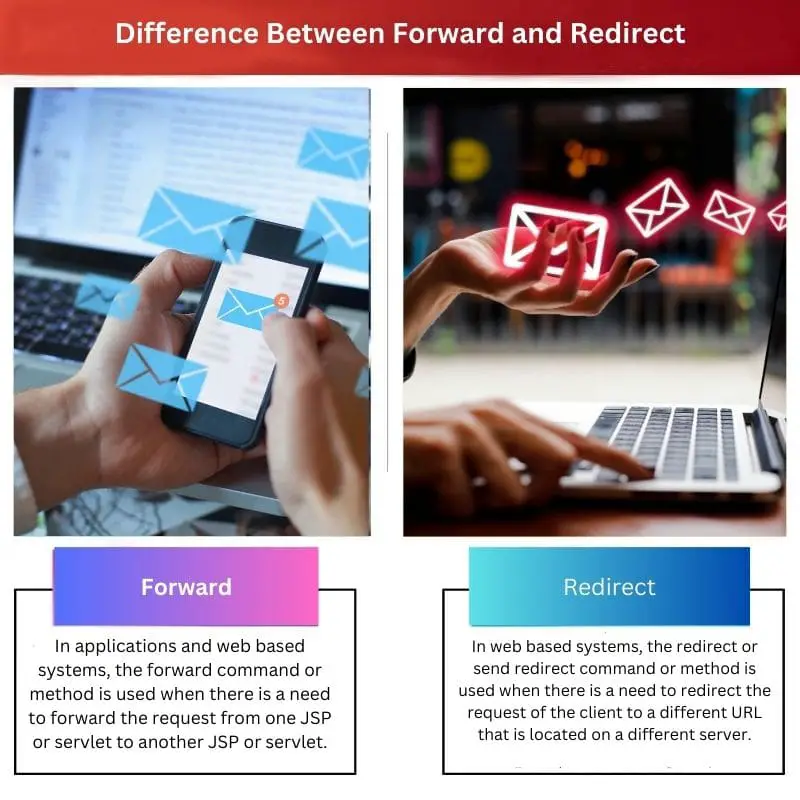Forwarding involves a server processing a request and passing it to another resource, while the client remains unaware. In contrast, redirection instructs the client to resend the request to a different URL, resulting in an additional HTTP request-response cycle and client awareness of the redirection.
Key Takeaways
- Forward refers to sending an email to another recipient without altering its content, while redirect involves sending the email to another recipient with modifications.
- Forwarding creates a new email thread, while redirecting retains the original thread.
- Forwarding may lead to privacy concerns, while redirecting helps maintain confidentiality.
Forward vs Redirect
Forward command is used in websites for transferring a client’s request from one JSP server to another JSP server. In forwarding command, the client is unaware of backend processing. Redirecting refers to sending clients’ requests from one server to another server with the involvement of the user.

The forward method in a web application takes forward the request of the client from one resource of a servlet to another resource of the same server.
The redirect method is a web application that redirects the request of the client from one window of a server to the window of another server. In the forward method, the client is completely unaware of the underlying process; in the redirect method, the client is aware of the process.
Comparison Table
| Feature | Forward | Redirect |
|---|---|---|
| Action | Transfers the request processing to another resource on the same server. | Sends a new request to a different resource, potentially on a different server. |
| User Experience | User’s browser address bar remains unchanged. | User’s browser address bar changes to the new resource’s URL. |
| Request Object | The original request object is used by the forwarded resource. | A new request object is created for the redirected resource. |
| Request Method | The original request method (e.g., GET, POST) is preserved. | The request method becomes a GET request, even if the original request was a different method (e.g., POST). |
| Data Transmission | Any form data submitted in the original request is still available to the forwarded resource. | Form data submitted in the original request is not automatically sent to the redirected resource. It needs to be handled specifically (e.g., using hidden form fields). |
| Purpose | Often used to include content from another resource, maintain state information, or handle internal server-side logic. | Used to change the location of the requested resource, inform the user about the change, or handle errors. |
| Examples | Including a header or footer template, processing form submissions without page reload, implementing security checks. | Moving to a login page after failed authentication, redirecting to a mobile-friendly version on a mobile device, handling broken links. |
What is Forward?
In web development, “forward” refers to the process of passing a client’s request from one resource to another within the server itself, without the client’s involvement. This mechanism is crucial for server-side programming to efficiently handle requests and maintain transparency with the client.
How Forward Works
When a client sends a request to a server, the server may decide to forward that request to another resource, such as a servlet or another web component, for further processing. This forwarding is done when different components within the server need to collaborate to fulfill the client’s request without the client being aware of the internal handling.
Benefits of Forwarding
- Efficiency: Forwarding allows the server to manage requests more efficiently by delegating tasks to specialized resources, reducing redundancy in code and operations.
- Transparency: Since forwarding occurs internally within the server, the client remains unaware of it, maintaining a seamless user experience without the need for additional client-side interactions.
- Modularity: Forwarding promotes modular code design by enabling different components within the server to work together effectively while maintaining clear separation of concerns.

What is Redirect?
Redirect in web development refers to the process of instructing the client’s browser to resend a request to a different URL. It’s a common technique used to direct users to a new location, either temporarily or permanently, in response to a particular request.
How Redirect Works
When a client sends a request to a server, the server may respond with an HTTP status code indicating a redirect (e.g., 301 for permanent redirect, 302 for temporary redirect). Along with this status code, the server includes a new URL to which the client should resend the request. The client’s browser then automatically initiates a new request to the provided URL.
Types of Redirects
- Permanent Redirect (301): This type of redirect informs the client’s browser that the requested resource has permanently moved to a new location. Search engines update their indexes with the new URL.
- Temporary Redirect (302): Here, the server informs the client’s browser that the requested resource is temporarily located elsewhere. The original URL might become available again in the future, so the browser should continue to use it.
- 303 See Other: This status code indicates that the response to the request can be found at a different URL. However, the client should use the GET method when resending the request to the new URL.
- 307 Temporary Redirect: Similar to a 302 redirect, but with the added requirement that the client should not change the request method (e.g., from POST to GET) when resending the request to the new URL.
Benefits of Redirects
- SEO Management: Redirects help manage website URLs, ensuring that search engines properly index the new locations of resources, thereby preserving SEO ranking.
- Maintainability: They facilitate the management of website structure changes or content migrations by seamlessly directing users and search engine crawlers to the new URLs.
- User Experience: Redirects enable the creation of intuitive navigation paths for users, ensuring they reach the desired content even when URLs change or pages are moved.

Main Differences Between Forward and Redirect
- Involvement of Client:
- Forward: The client remains unaware of the forwarding process as it occurs entirely within the server.
- Redirect: The client’s browser is instructed to resend the request to a different URL, making the client aware of the redirection.
- Number of Requests:
- Forward: Involves a single request-response cycle between the client and the server.
- Redirect: Initiates an additional request-response cycle as the client’s browser sends a new request to the redirected URL.
- Server-Side Processing:
- Forward: The server internally forwards the request to another resource for processing.
- Redirect: The server responds to the client’s request with an instruction to redirect to a different URL.





